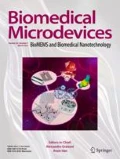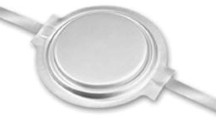Abstract
This paper describes a system for transferring power across a transdermal needle into a smart refill port for recharging implantable drug delivery systems. The device uses a modified 26 gauge (0.46 mm outer diameter) Huber needle with multiple conductive elements designed to couple with mechanical springs in the septum of the refill port of a drug delivery device to form an electrical connection that can sustain the current required to recharge a battery during a reservoir refill session. The needle is fabricated from stainless steel coated with Parylene, and the refill port septum is made from micromachined stainless steel contact springs and polydimethylsiloxane. The device properties were characterized with dry and wet ambient conditions. The needle and port pair had an average contact resistance of less than 2 Ω when mated in either environment. Electrical isolation between the system, the liquid in the needle lumen, and surrounding material has been demonstrated. The device was used to recharge a NiMH battery with currents up to 500 mA with less than 15°C of resistive heating. The system was punctured 100 times to provide preliminary information with regard to device longevity, and exhibited about 1 Ω variation in contact resistance. The results suggest that this needle and refill port system can be used in an implant to enable battery recharging. This allows for smaller batteries to be used and ultimately increases the volume efficiency of an implantable drug delivery device.










Similar content being viewed by others
Notes
Portions of this article appear in conference abstract form in Ref (Evans et al. 2009).
References
American Society of Health System Pharmacists, ASHP guidelines on quality assurance for pharmacy-prepared sterile products. Am J Health Syst Pharm 57, 12 (2000)
J.C. Andrews, S.C. Walker-Andrews, W.D. Ensminger, Long-term central venous access with a peripherally placed subcutaneous infusion port: initial results. Radiology, 176, 45–47 (1990), http://radiology.rsna.org/citmgr?gca=radiology;176/1/45
B.R. Boveja, A. Widhany, Method and system for providing pulsed electrical stimulation to provide therapy for erectile/sexual dysfunction, prostatitis, prostatitis pain, and chronic pelvic pain, U. S. Patent 7,330,762, 2008
M. Carmichael, The changing science of pain. Newsweek. 4 June 2007, 40–47, http://www.unboundmedicine.com/medline/ebm/record/17608126/full_citation/The_changing_science_of_pain_
T. Deer, I. Chapple, A. Classen, K. Javery, V. Stoker, L. Tonder, K. Burchiel, Intrathecal drug delivery for treatment of chronic low back pain: report from the National Outcomes Registry for Low Back Pain. Pain Med 5, 1 (2004)
S. Erdine, J. De Andres, Drug delivery systems. Pain Pract 6, 1 (2006)
A.T. Evans, S. Chiravuri, Y.B. Gianchandani, Transdermal Power Transfer for Implanted Drug Delivery Devices Using a Smart Needle and Refill Port. The 22nd IEEE Conference on Micro Electro Mechanical Systems (MEMS) (2009), pp. 252–256
M. Gerard, A. Chaubey, B.D. Malhotra, Application of conducting polymers to biosensors. Biosens Bioelectron 17, 5 (2002)
T.S. Grabow, D. Derdzinski, P.S. Staats, Spinal drug delivery. Curr Pain Headache Rep 5, 6 (2001)
Joint Committee on Accrediation of Healthcare Organizations, New standards to assess and manage pain. Jt Comm Perspect 19, 5 (1999)
H. Kim, K. Najafi, Characterization of Parylene-assisted Wafer Bonding: Long-term Stability and Influence of Process Chemicals. The 13th International Conference on Solid-State Sensors, Actuators and Microsystems (2005), pp. 2015–2018
R. Likar, W. Ilias, H. Kloimstein, A. Kofler, H.G. Kress, J. Neuhold, M.M. Pinter, M.C. Spendel, Stellenwert der intrathekalen Schmerztherapie. Der Schmerz 21(1), 15–27 (2007). doi:10.1007/s00482-006-0515-2
Medtronic Authors, Medtronic Sychromed II Pump, www.medtronic.com/your-health/multiple-sclerosis/device/our-baclofen-pump/synchromed-ii-pump/index.htm. Accessed October 08, 2008
S.L. Morris, P.F. Jaques, M.A. Mauro, Radiology-assisted placement of implantable subcutaneous infusion ports for long-term venous access. Radiology 184, 1 (1992)
C.J. Phillips, Pain management: health economics and quality of life considerations. Drugs 63, 2 (2003)
N.G. Rainov, V. Heidecke, Management of chronic back and leg pain by intrathecal drug delivery. Acta Neurochir Suppl 97, 1 (2007)
R.L. Rauck, D. Cherry, M.F. Boyer, P. Kosek, J. Dunn, K. Alo, Long-term intrathecal opioid therapy with a patient-activated, implanted delivery system for the treatment of refractory cancer pain. J Pain 4, 8 (2003)
D. Reynaerts, J. Peirs, H. Van Brussel, A SMA-Actuated Implantable System for Delivery of Liquid Drugs, Proceedings of the Fifth International Conference on New Actuators, 1996
M.T. Richardson, Y.B. Gianchandani, Achieving precision in high density batch mode micro-electro-discharge-machining. J Micromechanics Microengineering 18, 1 (2008)
S.A. Schug, D. Saunders, I. Kurowski, M.J. Paech, Neuraxial drug administration: a review of treatment options for anaesthesia and analgesia. CNS Drugs 20, 11 (2006)
M.L. Soria, J. Chacon, J.C. Hernandez, Metal hydride electrodes and Ni/MH batteries for automotive high power applications. J Power Sourc 102, 1–2 (2001)
S. Strum, J. McDermed, A. Korn, C. Joseph, Improved methods for venous access: the Port-A-Cath, a totally implanted catheter system. J Clin Oncol 4, 596–603 (1986)
R. Tajima, K. Satoshi, M. Inaba, H. Inoue, Development of soft and distributed tactile sensors and the application to a humanoid robot. Adv Robot 16, 4 (2002)
K. Takahata, Y.B. Gianchandani, Batch mode micro-electro-discharge machining. IEEE ASME J Microelectromech Syst 11, 2 (2002)
R. Vipul, Vipul’s lifetime lifeline permanent pacemaker and implantable cardioverter-defibrillator, U. S. Patent 7,239,917, 2007
D.P. Wermeling, Ziconotide an intrathecally administered N-type calcium channel antagonist for the treatment of chronic pain. Pharmacotherapy 25, 8 (2005)
M. Winkelmuller, W. Winkelmuller, Long-term effects of continuous intrathecal opioid treatment in chronic pain of nonmalignant etiology. J Neurosurg 85, 3 (1996)
Author information
Authors and Affiliations
Corresponding author
Additional information
An erratum to this article can be found at http://dx.doi.org/10.1007/s10544-010-9397-2
Rights and permissions
About this article
Cite this article
Evans, A.T., Chiravuri, S. & Gianchandani, Y.B. Transdermal power transfer for recharging implanted drug delivery devices via the refill port. Biomed Microdevices 12, 179–185 (2010). https://doi.org/10.1007/s10544-009-9371-z
Published:
Issue Date:
DOI: https://doi.org/10.1007/s10544-009-9371-z




